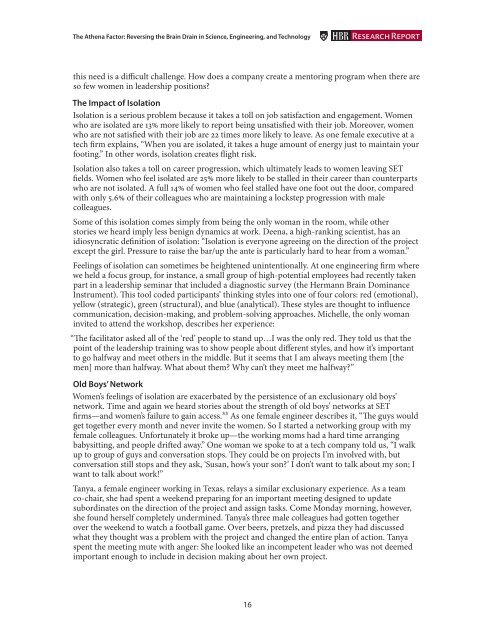HD6060-.A84-2008-PDF-Athena-factor-Reversing-the-brain-drain-in-science,-engineering,-and-technology
HD6060-.A84-2008-PDF-Athena-factor-Reversing-the-brain-drain-in-science,-engineering,-and-technology
HD6060-.A84-2008-PDF-Athena-factor-Reversing-the-brain-drain-in-science,-engineering,-and-technology
Create successful ePaper yourself
Turn your PDF publications into a flip-book with our unique Google optimized e-Paper software.
The <strong>A<strong>the</strong>na</strong> Factor: <strong>Revers<strong>in</strong>g</strong> <strong>the</strong> Bra<strong>in</strong> Dra<strong>in</strong> <strong>in</strong> Science, Eng<strong>in</strong>eer<strong>in</strong>g, <strong>and</strong> Technology<br />
HBR Research Report<br />
this need is a difficult challenge. How does a company create a mentor<strong>in</strong>g program when <strong>the</strong>re are<br />
so few women <strong>in</strong> leadership positions?<br />
The Impact of Isolation<br />
Isolation is a serious problem because it takes a toll on job satisfaction <strong>and</strong> engagement. Women<br />
who are isolated are 13% more likely to report be<strong>in</strong>g unsatisfied with <strong>the</strong>ir job. Moreover, women<br />
who are not satisfied with <strong>the</strong>ir job are 22 times more likely to leave. As one female executive at a<br />
tech firm expla<strong>in</strong>s, “When you are isolated, it takes a huge amount of energy just to ma<strong>in</strong>ta<strong>in</strong> your<br />
foot<strong>in</strong>g.” In o<strong>the</strong>r words, isolation creates flight risk.<br />
Isolation also takes a toll on career progression, which ultimately leads to women leav<strong>in</strong>g SET<br />
fields. Women who feel isolated are 25% more likely to be stalled <strong>in</strong> <strong>the</strong>ir career than counterparts<br />
who are not isolated. A full 14% of women who feel stalled have one foot out <strong>the</strong> door, compared<br />
with only 5.6% of <strong>the</strong>ir colleagues who are ma<strong>in</strong>ta<strong>in</strong><strong>in</strong>g a lockstep progression with male<br />
colleagues.<br />
Some of this isolation comes simply from be<strong>in</strong>g <strong>the</strong> only woman <strong>in</strong> <strong>the</strong> room, while o<strong>the</strong>r<br />
stories we heard imply less benign dynamics at work. Deena, a high-rank<strong>in</strong>g scientist, has an<br />
idiosyncratic def<strong>in</strong>ition of isolation: “Isolation is everyone agree<strong>in</strong>g on <strong>the</strong> direction of <strong>the</strong> project<br />
except <strong>the</strong> girl. Pressure to raise <strong>the</strong> bar/up <strong>the</strong> ante is particularly hard to hear from a woman.”<br />
Feel<strong>in</strong>gs of isolation can sometimes be heightened un<strong>in</strong>tentionally. At one eng<strong>in</strong>eer<strong>in</strong>g firm where<br />
we held a focus group, for <strong>in</strong>stance, a small group of high-potential employees had recently taken<br />
part <strong>in</strong> a leadership sem<strong>in</strong>ar that <strong>in</strong>cluded a diagnostic survey (<strong>the</strong> Hermann Bra<strong>in</strong> Dom<strong>in</strong>ance<br />
Instrument). This tool coded participants’ th<strong>in</strong>k<strong>in</strong>g styles <strong>in</strong>to one of four colors: red (emotional),<br />
yellow (strategic), green (structural), <strong>and</strong> blue (analytical). These styles are thought to <strong>in</strong>fluence<br />
communication, decision-mak<strong>in</strong>g, <strong>and</strong> problem-solv<strong>in</strong>g approaches. Michelle, <strong>the</strong> only woman<br />
<strong>in</strong>vited to attend <strong>the</strong> workshop, describes her experience:<br />
“The facilitator asked all of <strong>the</strong> ‘red’ people to st<strong>and</strong> up…I was <strong>the</strong> only red. They told us that <strong>the</strong><br />
po<strong>in</strong>t of <strong>the</strong> leadership tra<strong>in</strong><strong>in</strong>g was to show people about different styles, <strong>and</strong> how it’s important<br />
to go halfway <strong>and</strong> meet o<strong>the</strong>rs <strong>in</strong> <strong>the</strong> middle. But it seems that I am always meet<strong>in</strong>g <strong>the</strong>m [<strong>the</strong><br />
men] more than halfway. What about <strong>the</strong>m? Why can’t <strong>the</strong>y meet me halfway?”<br />
Old Boys’ Network<br />
Women’s feel<strong>in</strong>gs of isolation are exacerbated by <strong>the</strong> persistence of an exclusionary old boys’<br />
network. Time <strong>and</strong> aga<strong>in</strong> we heard stories about <strong>the</strong> strength of old boys’ networks at SET<br />
firms—<strong>and</strong> women’s failure to ga<strong>in</strong> access.33 As one female eng<strong>in</strong>eer describes it, “The guys would<br />
get toge<strong>the</strong>r every month <strong>and</strong> never <strong>in</strong>vite <strong>the</strong> women. So I started a network<strong>in</strong>g group with my<br />
female colleagues. Unfortunately it broke up—<strong>the</strong> work<strong>in</strong>g moms had a hard time arrang<strong>in</strong>g<br />
babysitt<strong>in</strong>g, <strong>and</strong> people drifted away.” One woman we spoke to at a tech company told us, “I walk<br />
up to group of guys <strong>and</strong> conversation stops. They could be on projects I’m <strong>in</strong>volved with, but<br />
conversation still stops <strong>and</strong> <strong>the</strong>y ask, ‘Susan, how’s your son?’ I don’t want to talk about my son; I<br />
want to talk about work!”<br />
Tanya, a female eng<strong>in</strong>eer work<strong>in</strong>g <strong>in</strong> Texas, relays a similar exclusionary experience. As a team<br />
co-chair, she had spent a weekend prepar<strong>in</strong>g for an important meet<strong>in</strong>g designed to update<br />
subord<strong>in</strong>ates on <strong>the</strong> direction of <strong>the</strong> project <strong>and</strong> assign tasks. Come Monday morn<strong>in</strong>g, however,<br />
she found herself completely underm<strong>in</strong>ed. Tanya’s three male colleagues had gotten toge<strong>the</strong>r<br />
over <strong>the</strong> weekend to watch a football game. Over beers, pretzels, <strong>and</strong> pizza <strong>the</strong>y had discussed<br />
what <strong>the</strong>y thought was a problem with <strong>the</strong> project <strong>and</strong> changed <strong>the</strong> entire plan of action. Tanya<br />
spent <strong>the</strong> meet<strong>in</strong>g mute with anger: She looked like an <strong>in</strong>competent leader who was not deemed<br />
important enough to <strong>in</strong>clude <strong>in</strong> decision mak<strong>in</strong>g about her own project.<br />
16


